With the 2020 en primeur campaign now in full swing, the past two days have seen releases from the likes of Angélus, the Barton family, the Perse family, and more.
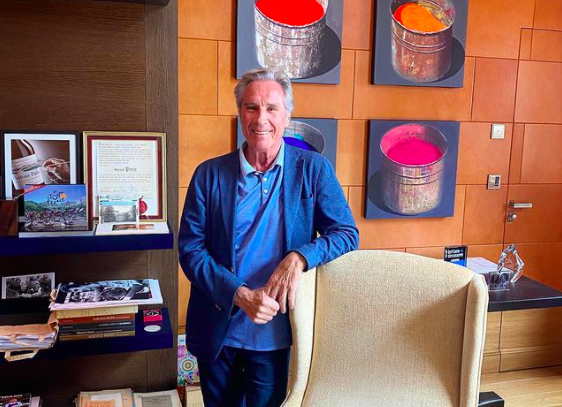 “Another big step in the right direction for this château in revealing its excellent terroir” – Wine Lister, CEO Ella Lister, who visited Pavie’s owner, Gérard Perse (pictured) last year
“Another big step in the right direction for this château in revealing its excellent terroir” – Wine Lister, CEO Ella Lister, who visited Pavie’s owner, Gérard Perse (pictured) last year
Released yesterday morning (Tuesday 18th May), the latest vintage of the Barton family wines – Léoville Barton, Langoa Barton, and Mauvesin Barton – has reportedly seen a positive uptake in the UK market already. Wine Lister partner critic, Jancis Robinson, gives high praise to the flagship release, Léoville Barton, awarding it 18 points, and noting that it shows “very fine winemaking indeed”, adding, “I have to admit I was tempted to swallow this, it was so majestic”. Wine Lister’s CEO, Ella Lister, also commends the latest vintage, describing a “sculptured structure which takes it into a different register”. The 2020 was released at £60.80 per bottle in-bond – over 10% higher than last year’s release, but potentially sporting the wine’s best quality to date.
Two more Saint-Émilion Grand Crus Classés “A” have joined fellow comrade and early-bird release Cheval Blanc, with Angélus entering the market at £254 per bottle (in-bond), and Pavie following closely behind at c.£241 per bottle (in-bond).
The latter gained resounding praise this year: James Lawther (for JancisRobinson.com) notes “absolute precision” which he says “more than highlights the change in style,” concluding, “one of the best yet”. Ella echoes this sentiment, asserting that “delightful floral freshness and a feather-light texture mark another big step in the right direction for this château in revealing its excellent terroir,” and calling the wine ”complex and refined”. The comments combined suggest that Pavie 2020 is the culmination of stylistic changes undertaken by the property over the last few years.
Perse family sibling, Pavie-Decesse 2020 was also released yesterday at £83 per bottle (in-bond). The latest vintage gains 17 points from James Lawther, who describes “Tension and minerality as well but plenty of charm this year”. With virtually no stocks of last year’s release remaining on the market, and the estate offering an element of rarity (at 3.5ha, it is a 10th of the size of Pavie), the latest release is likely to gain appeal beyond its volume released.
Also released so far this week are: Marquis d’Alesme, Labégorce, Coutet, Guiraud, Bellevue-Mondotte, and Monbousquet.
The Bordeaux en primeur 2020 campaign began in earnest last week, with Cheval Blanc the first of the major releases out of the gate. Its latest vintage was offered at a small, 3% increase on the 2019 release price, which itself came to market with a generous discount of c.30% on the previous year.
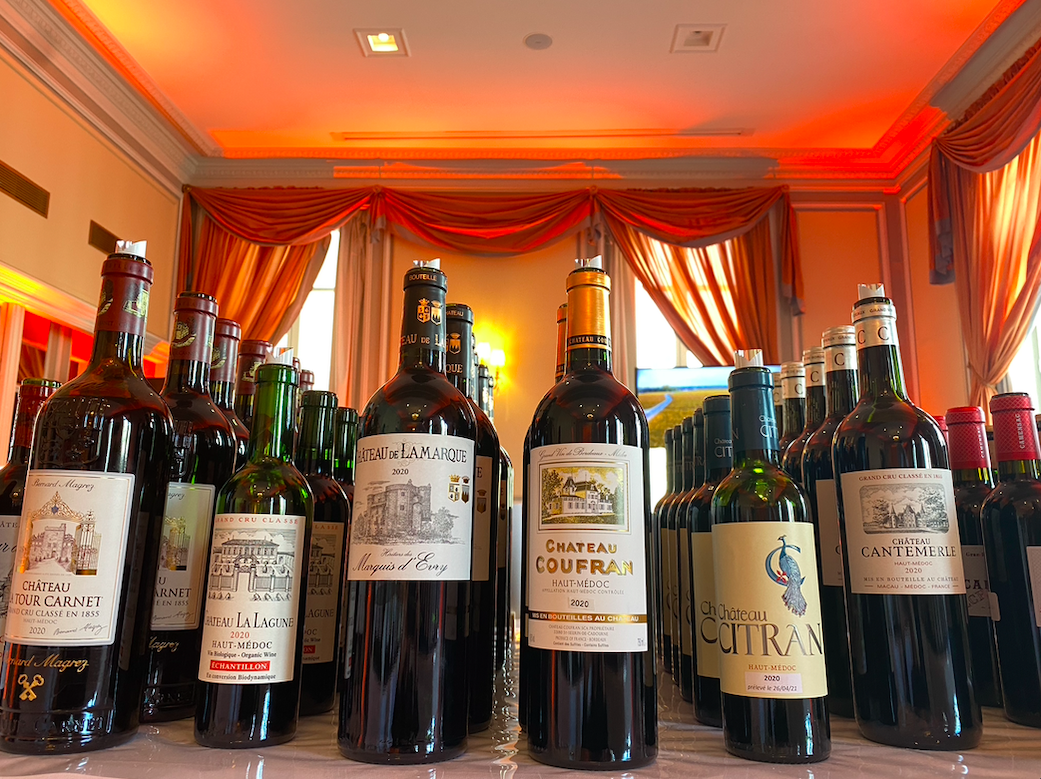 UGCB Tasting at The Intercontinental Hotel Bordeaux, attended by Wine Lister CEO, Ella Lister
UGCB Tasting at The Intercontinental Hotel Bordeaux, attended by Wine Lister CEO, Ella Lister
Absence makes the heart grow fonder
Much of the international trade has entered into a second consecutive year without the normal en primeur tasting week in situ. Instead, the bordelais have generally come up trumps with sending samples this year (only a very small handful of châteaux have declined to send any at all), and in many cases, one-on-one video calls have replaced the fleeting group tasting slots at the estates. Edouard Moueix, Managing Director of Etablissements Jean-Pierre Moueix observes how this has actually been a help, rather than a hindrance, in telling the story of the vintage to clients: “we can take time to explain things like we did some years ago”, he says. With a much wider range of tastings this year (albeit remotely for most) and a slightly less condensed campaign schedule, this should allow room for lesser-known wines that have excelled in the vintage to shine, where last year the sale of 2019s at lightning speed favoured well-known and trusted brands in the main.
While pricing is more often than not the hot topic for many participants in en primeur campaigns, sales of 2020 have the potential for focus on the great stories of each individual Bordeaux estate, given that the price equation this year is perhaps simpler than it has been in recent years.
Following a broadly successful “price reset” through the 2019 campaign, Bordeaux is holding all the cards that should ensure en primeur sales of 2020 work just as well (if not better), riding the wave of renewed interest in Bordeaux created last year. If 2019 prices set the precedent, then all that need happen now is to follow suit – matching last year’s release price, since the quality of 2020 for the majority of wines does the same. A healthier GBP-Euro exchange rate than existed last year should also help to keep price tags attractive, and choices for top-quality, excellent-value wines will hopefully be available in spades.
Follow Wine Lister’s en primeur analysis here on our blog, where we will be highlighting top picks from the 2020 vintage as they are released.
Recap Part I of our Bordeaux Study here for further analysis of en primeur pricing.
Cheval Blanc 2020 was one of the first key releases out of the gate for this year’s Bordeaux en primeur campaign yesterday.
Having tasted in Bordeaux last week, Wine Lister’s CEO, Ella Lister, hails the wine “restrained and profound” on the nose, with “dark, hypnotic fruit”. The palate, she says, is “straight-lined, mineral, mouth-watering and fresh”, with an “incredibly long, saline finish”. As one of her favourite wines of the vintage, she would potentially give it a perfect score.
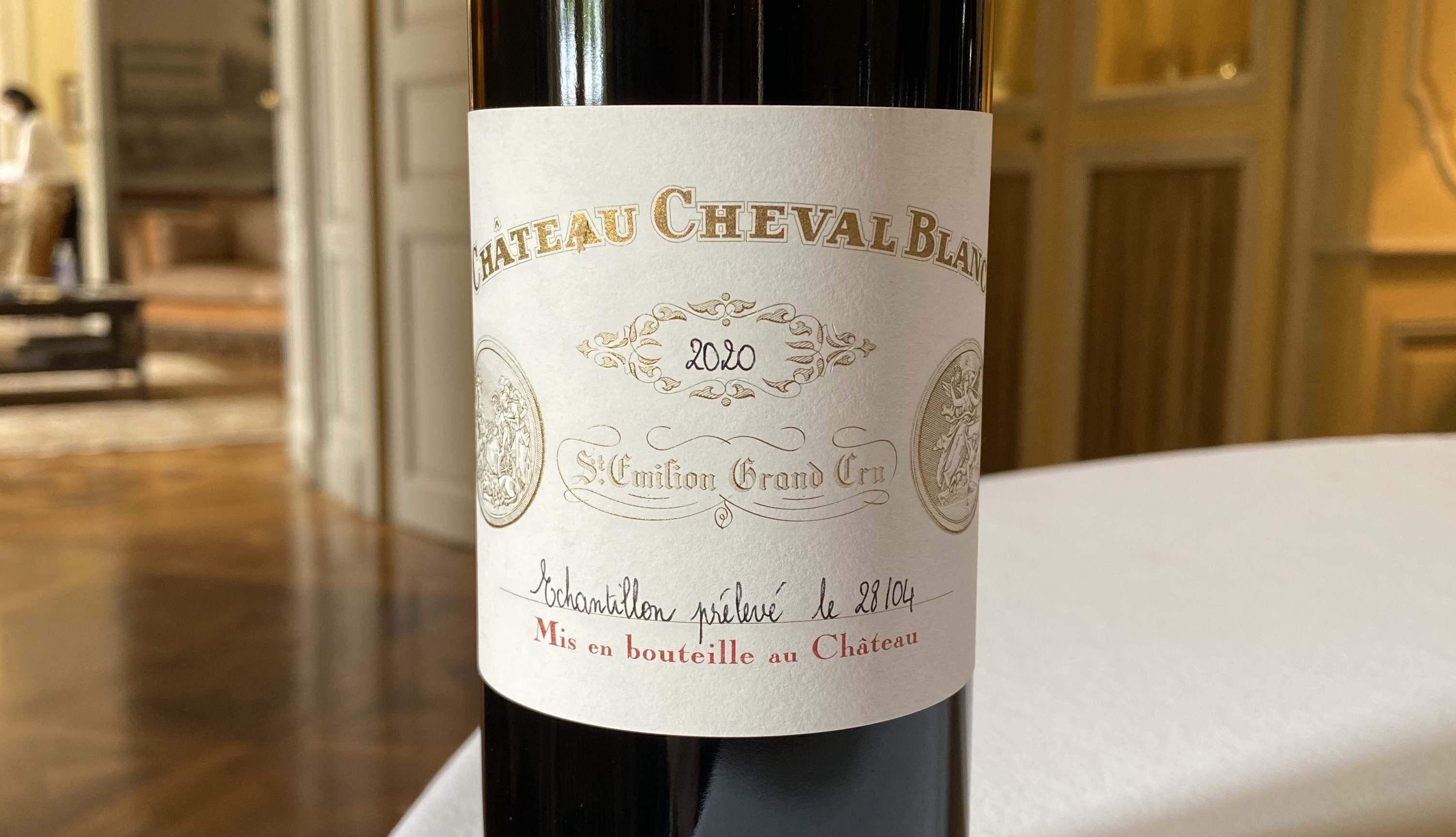
Technical Director, Pierre-Olivier Clouet notes that 2020 is cut quite differently from recent years at the estate. He characterises the vintage at Cheval Blanc in “three major waves”. First, the humid spring encouraged the vines to grow calmly and homogenously, accumulating water and nutrients much needed later in the season. The second wave was one of drought, which Clouet explains gives Cheval Blanc 2020 “a deep, tannic structure – dense but not hard, firm but not dry, ripe but not cooked”. Balancing this is Clouet’s “third wave” – a period of intense heat towards the end of the summer. With temperatures during harvest reaching 38-39 degrees Celsius, the hot spell translates into a very “expressive, intense, crisp, and aromatic nose”, and a freshness on the palate thanks to quick picking, within 20 days (half the usual duration).
Cheval Blanc 2020 was being offered by UK merchants at around £380 per bottle in-bond – 3% above the 2019 release price, but well under the price of any small remaining quantities of 2019 currently available on the British secondary market. Last year’s gesture on pricing was exceptionally well-received, and the 2020 will likely be no exception.
Speaking with some of the region’s top producers, Wine Lister CEO, Ella Lister provides her overview of Bordeaux’s 2020 vintage.
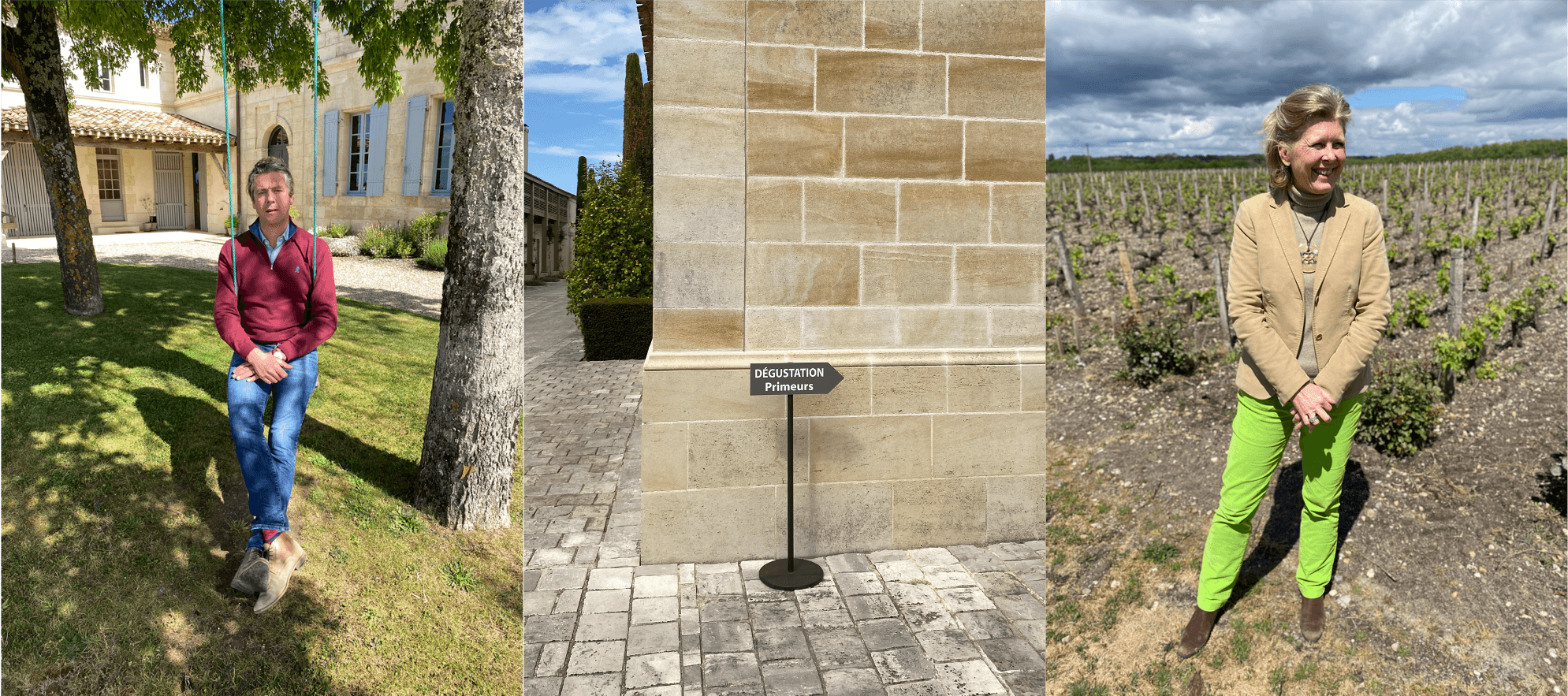 Left: Baptise Guinaudeau of Lafleur and Grand Village / Right: Véronique Sanders of Haut-Bailly and Le Pape
Left: Baptise Guinaudeau of Lafleur and Grand Village / Right: Véronique Sanders of Haut-Bailly and Le Pape
What should we expect from Bordeaux 2020?
2020 is an unprecedented vintage both in terms of the pandemic context and its juxtaposition of tannic power and exquisite freshness. On both banks of Bordeaux, the wines are characterised by an early growing season that underwent a series of extremes: a warmer winter than usual, a rainier spring, and a record dry summer, without so much as a drop of rain from mid-June to mid-August, then finally exceedingly hot during the harvest (one should spare a thought for the masked pickers). In spite of such difficulties, Veronique Sanders of Château Haut-Bailly notes that “the easy vintages in Bordeaux used to be the best ones, but in recent years that’s not the case”.
Henri Lurton, owner of Château Brane-Cantenac in Margaux, referred to 2020 as a “quite unique” vintage, both “hot and classic” at the same time. This observation is echoed by Baptiste Guinaudeau, co-owner of Château Lafleur in Pomerol, who recognises in 2016, 2018, and now 2020, a new type of growing season that didn’t exist before, uniting a big, sunny vintage like 2009 with a more classical vintage like 2008. 2020 is “multiple vintages in a single wine”, according to Lafleur’s cellar master, Omri Ram.
While several wines in 2020 in have record tannic density, you wouldn’t know it without the technical analyses. When you taste the wines, this power hidden by a delicate, diaphanous veil. Acidity remains decently high, and alcohol relatively low, allowing the wines to maintain the classicism that we recognise and love in Bordeaux.
In a year where the Bordelais couldn’t go on their usual marketing trips to the US, China and beyond, they were closer to the vines and to nature. This often meant whole teams dedicated to the vine-growing and winemaking instead of sales and marketing. This often meant whole teams dedicated to the vine-growing and winemaking instead of sales and marketing. “Un vin d’équipe”, says Marielle Cazaux, technical director of La Conseillante, referring to the unprecedented “team effort”, as the office staff worked in the vineyards, helping the vines through extreme rain, then drought, then heat.
Completing a trilogy of excellent vintages, after 2018 et 2019, 2020 is nonetheless more heterogeneous, where the top terroirs were best able to cope with the extreme climatic conditions. Each appellation boasts some exceptional wines, be it Pauillac, Pessac-Léognan or Pomerol. And these wines have a floral freshness, often of peonies or iris (the latter a scent deriving from merlot when it undergoes hydric stress).
Finally, the whites deserve a special mention in 2020. A vintage for lovers of richer, creamier whites, we found the best almost Burgundian, without the varietal grassiness of Sauvignon Blanc.
As Wine Lister enters its fifth year in business, we are excited to announce the addition of 650 new wines onto Wine Lister’s information hub. Thanks to scores from our trusted partner critics, prices through our official pricing partner, Wine Owners, and data measuring popularity, as determined by the number of searches on Wine-Searcher (Pro and Pro+ site only), website users can now discover Wine Lister scores, prices, and apply decision-making analysis tools to a broader range of fine wines. With the latest additions, our database now extends across 4,450 wines, and over 40,000 wine-vintages, providing further insight to inform wine investment choices and strategic solutions.
Below we examine the regional split of the additional wines, and take a closer look at some of the properties featured in the expansion.
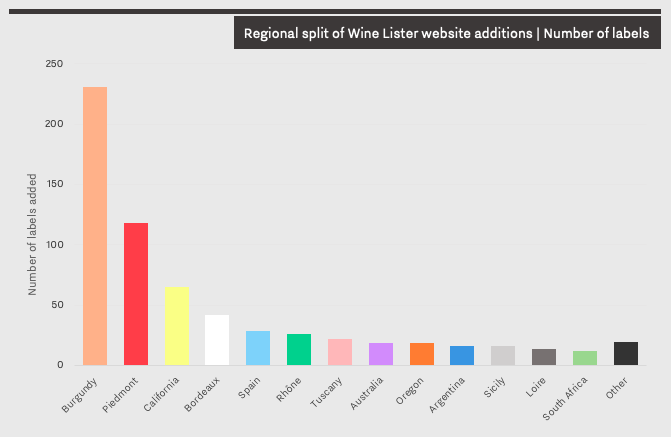
Burgundy represents 36% of the new selection, with more cuvées added from the likes of Pierre-Yves Colin-Morey, Cécile Tremblay, Benjamin Leroux, and more. A further 42 wines (6%) are added to the already-established set of Bordeaux properties featured on the Wine Lister site, including Cru Bourgeois Exceptionnels, Cambon La Pelouse, and Malescasse. Domaine des Roches Neuves represents seven out of the 10 new additions from the Rhône, alongside Bernard Baudry and Domaine du Closel.
Wine Lister’s Italian listings grow by 24% in the latest update, including 118 additions from Piedmont, 22 from Tuscany, and 16 from Sicily. The new Piedmontese picks include Arnaldo Rivera Barolo, Elvio Cogno, Figli Luigi Oddero, Giuseppe Mascarello e Figlio, and more. A region on the rise, Sicilian additions include new wines from organic Etna producers, Tenuta delle Terre Nere and Passopisciaro.
Wine Lister has also expanded its New World portfolio, which now features more additions from California (10% of the latest haul), Australia, and Oregon, among other regions. Featured amongst the new Californian picks are rising estates such as Littorai, Quintessa, Bevan, and Cardinale. Moving up the West Coast, Oregon additions include five new wines from Evening Land, four new bottles from Bergstrom, and three new picks from Antica Terra.
For more industry insights and advice on which wines and regions to buy, sign up for Wine Lister’s free newsletter here. Members of the trade can sign up to the Pro account to search and filter wines by Wine Lister Pro metrics.
Any of the producers recently added to the Wine Lister website can provide us with additional information on their wines, including production volumes, grape varieties, and label images. Email us at: team@wine-lister.com.
As the fine wine industry starts preparing for another Bordeaux en primeur season at a distance, Wine Lister has published Part I of its annual in-depth Bordeaux Study. With insights from key fine wine trade players from across the globe, Part I evaluates Bordeaux’s recent performance, considers the major takeaways from the 2019 vintage campaign, and contemplates the lessons they might provide moving forwards.
Please see our key findings below:
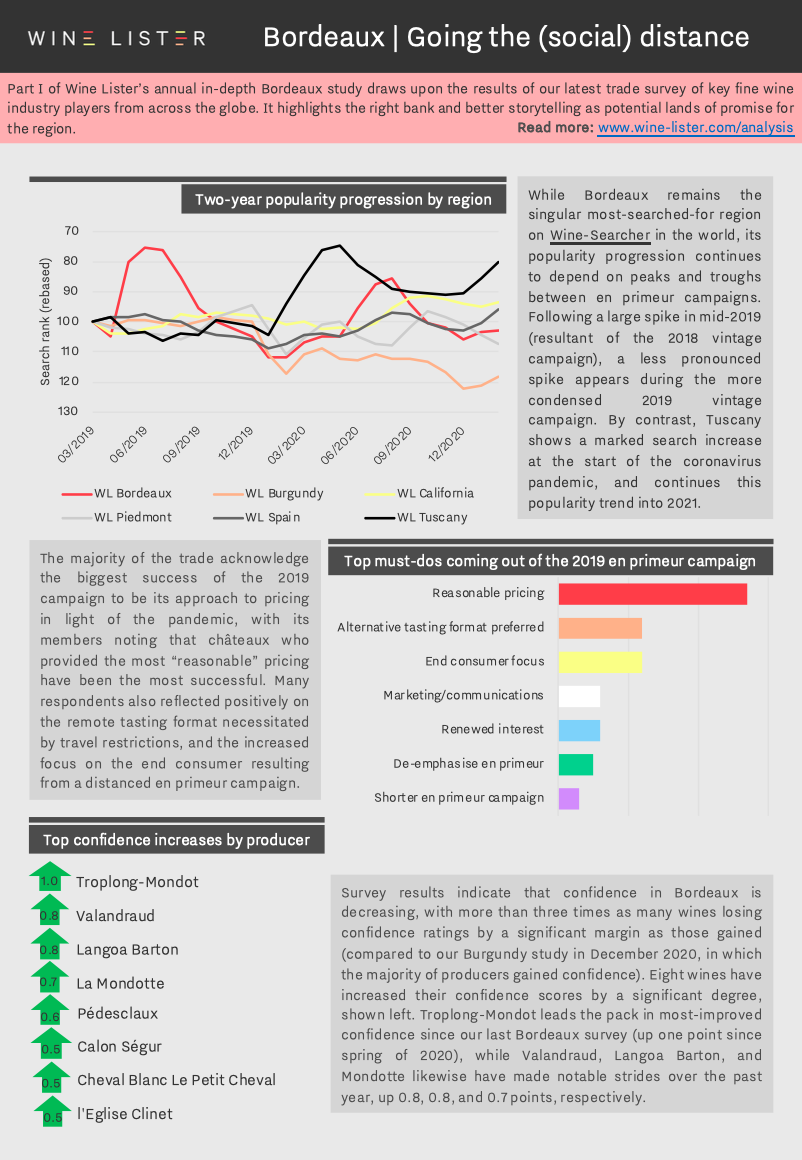
You can download the study digest in English here: Wine Lister 2021 Bordeaux Study – Digest or French here: Wine Lister 2021 Bordeaux Résumé d’étude. The full report can be purchased on our Analysis page, while Pro subscribers can access their free copy here.
With Bordeaux 2020 en primeur fast approaching, Wine Lister reports on one of the latest updates to emerge from the Médoc, informing your investment decisions over the coming months. In collaboration with Château Lafon-Rochet, we speak to Basile Tesseron to find out more about the inaugural partnership of two of the most revered consultants in Bordeaux to work on the estate’s 2020 blend: Jean-Claude Berrouet and Eric Boissenot.

Renowned for his expertise in Merlot production at Pomerol’s Château Petrus, Lafon-Rochet’s existing consultant, Jean-Claude Berrouet has been working at the estate alongside his son, Jeff, since 2012. Basile tells us that his team “admire the quality of the tannins present in the wines that Jean-Claude consults on, as well as his expertise with grapes coming from clay soils”.
With almost half of the estate based on clay, and the other half on dry, deep, gravely soils, he explains that “it was logical to combine Jean-Claude’s work with that of Eric Boissenot”, whose father, Jacques, has also been working with Lafon-Rochet for several years. With a reputation as oenologist to some of the Médoc’s top châteaux, Eric Boissenot is known for his dedication to the accentuation of terroir.
This meeting of minds from the Right and Left Banks for the first time illustrates another step in the evolution of Lafon-Rochet under Basile’s guidance. Since taking over the running of the estate in 2007, he has overseen the construction of two new cellars, extensive replanting, and a dedicated biodiversity programme. Having spent several years conducting agroforestry trials, last year Lafon-Rochet embarked on an agroforestry scheme that aims to make the estate wild once again through assisted natural regeneration. As well as installing bat nesting boxes and beehives, the property aims to plant 13,000 trees on its land by 2022.
Click here to sign up to Wine Lister’s free newsletter to keep track of everything en primeur over the coming months, including our recommendations on which releases to buy.
WL PR offers a dedicated communications service to help fine wine producers tell their story within the UK market. Head to our services page here to find out more.
Having commenced the week with International Women’s Day (Monday 8th March), Wine Lister’s latest blog celebrates some of the leading female figures in winemaking. Interviewing a handful of top producers across six regions, whose practices embody a range of principals, we put a spotlight on the wines made by some of the industry’s most exceptional women.
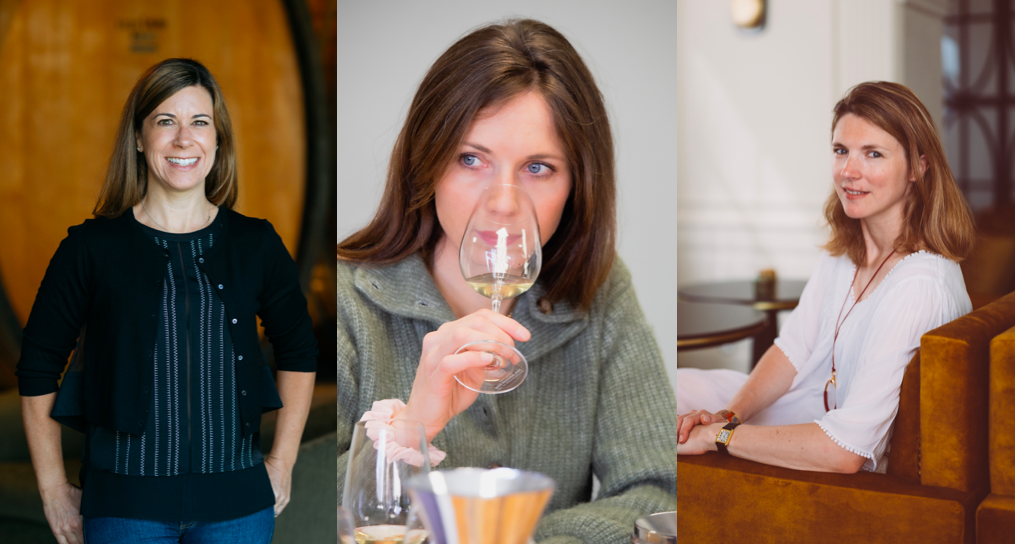 From left: Ashley Hepworth, Caroline Frey, and Stéphanie de Boüard-Rivoal
From left: Ashley Hepworth, Caroline Frey, and Stéphanie de Boüard-Rivoal
Ashley Hepworth – Joseph Phelps Vineyards
Following a degree in Chemistry and Biology, Ashley Hepworth spent two years cooking at Charlie Trotter’s legendary Chicago restaurant, where she realised she “wanted to learn more about wine and utilize [her] science background”. After studying the restaurant’s wines, and quizzing its Master Sommeliers, she applied for a harvest internship at Joseph Phelps where she continued to work her way “up the ladder”, eventually becoming winemaker in 2008. She is “particularly fond” of the 2008, 2015, and 2017 vintages of Joseph Phelps’ flagship wine, Insignia, explaining that each are “distinctive of the given vintage and the interplay of the six estate vineyards” that the wine is blended from.
Caroline Frey – La Lagune and Paul Jaboulet Aîné
Having taken the helm of third-growth property La Lagune from her father in 2004, Caroline Frey has since assumed an additional winemaking role in the Rhône, at Paul Jaboulet Aîné, after its acquisition by her family in 2005. Like several of the producers we spoke to, Caroline informs us that working “in harmony with nature is a long-term project” for her, with both properties now certified biodynamic. She explains that “to produce great wine the grapes must be the fruit of nature and not of synthetic chemistry”, and the more she “improves in working in harmony with nature” the “more wonderful” her wine will be.
Stéphanie de Boüard-Rivoal – Angélus
Having spent her childhood at Angélus, Stéphanie de Boüard-Rivoal was seven years old when she told her grandfather, Jacques de Boüard de Laforest, that she wanted to join him and her father, Hubert, in running the estate. After an early career in London’s financial sector, Stéphanie returned to Angélus in 2012, and has since continued a “quest for excellence while endeavouring to keep the estate in [her] family”. Noting “purity, tension, and focus” as key words to describe the style of her wine, she tells us that she is currently fond of Angélus’ 2005 and 2010 vintages, and anticipates enjoyment of the 2016 and 2018 in the coming years.
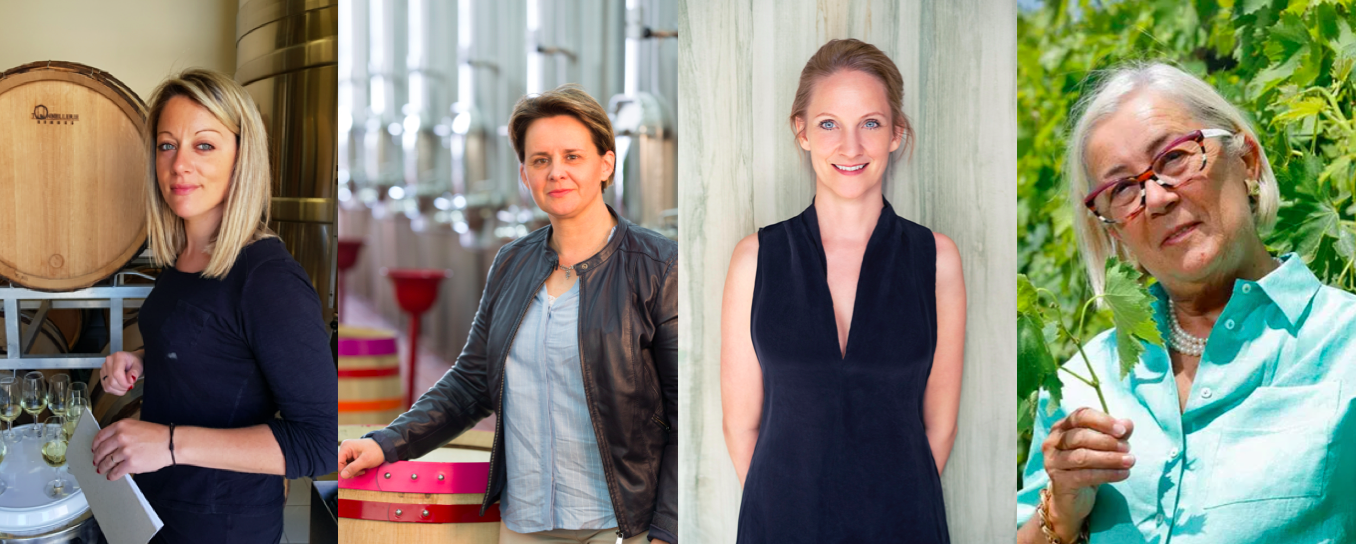 From left: Charlène Pinson, Florence Heresztyn-Mazzini, Eva Fricke, and Donatella Cinelli Colombini
From left: Charlène Pinson, Florence Heresztyn-Mazzini, Eva Fricke, and Donatella Cinelli Colombini
Charlène Pinson – Pinson
One of the longest-established families in Chablis, records show that the Pinsons have been producing in the region since 1640. Having joined her father, Laurent, at the estate in 2008, Charlène Pinson tells us of her respect for tradition and the work that her family has done before her, with the aim to “pass on the passion” to her two sons. Producing 13 different wines, she explains that each is a “reflection of their terroirs”, and are “more or less floral and fruity” depending on the slope and soil of the parcel. For those new to Pinson, she recommends the 2017 Chablis Mont de Milieu, describing it as a “pure expression of our Kimmeridgian limestones […] classic, mineral, balanced, and fresh”.
Florence Heresztyn-Mazzini – Heresztyn-Mazzini
Taking over her family’s estate (Domaine Heresztyn) in 2012, Florence Heresztyn-Mazzini and her husband, Simon Mazzini have overseen numerous developments under its new name. Introducing biodynamic practices in 2015, and achieving organic certification in 2019, Florence continues to “experiment with natural treatments” to fulfil her goal of “fighting the challenges of climate change”, including more “cover crops and sustainable pruning”. Explaining that many recent vintages have been difficult due to global warming, she tells us that she is particularly proud of her “fights” in 2013 and 2016, creating top quality wines in years that “remind us that we are small in the face of Mother Nature!”.
Eva Fricke – Eva Fricke
After making wine in Australia, Spain, and Germany, Eva Fricke returned to Germany in 2006 to start her own estate, which now holds 17ha across the Rheingau. Achieving organic certification in 2016 and membership in The Vegan Society in 2017, the property also employs several biodynamic practices including its adherence to the lunar calendar. She tells us that these principals guide her goals of developing a domain that “stands for organic, sustainable, and socially conscious standards”. Eva notes the “2019 Lorcher Schlossberg, 2019 Lorcher Krone Trocken, and 2019 Lorcher Krone Trockenbeerenauslese” as some of her top wines.
Donatella Cinelli Colombini – Casato Prime Donne and Fattoria del Colle
Born into a family of winemakers whose production in Montalcino can be traced back to 1592, Donatella Cinelli Colombini tells that it is “for this reason” that winemaking comes naturally to her. Founding Italy’s first winery run solely by women, she explains that her decision to have an all-female staff at Casato Prime Donne “leaves an imprint of acute accuracy in each step of the production process”. She notes of Casato Prime Donne wines that they are some of the first “chosen, and produced by women, for women”.
Like many of the world’s winemaking regions, Barolo is increasingly subject to dramatic weather patterns as a result of global warming. With significant frost in spring followed by an extremely hot summer, its 2017 growing season was no exception to these severe shifts. Akin to its vines, Barolo’s producers are now more than ever demonstrating their resilience to change, as evident in its latest offerings.
To guide those buying Barolo 2017 over the coming weeks, Wine Lister has spoken to nine of the region’s top producers to get a better picture of the vintage and its viticultural demands.
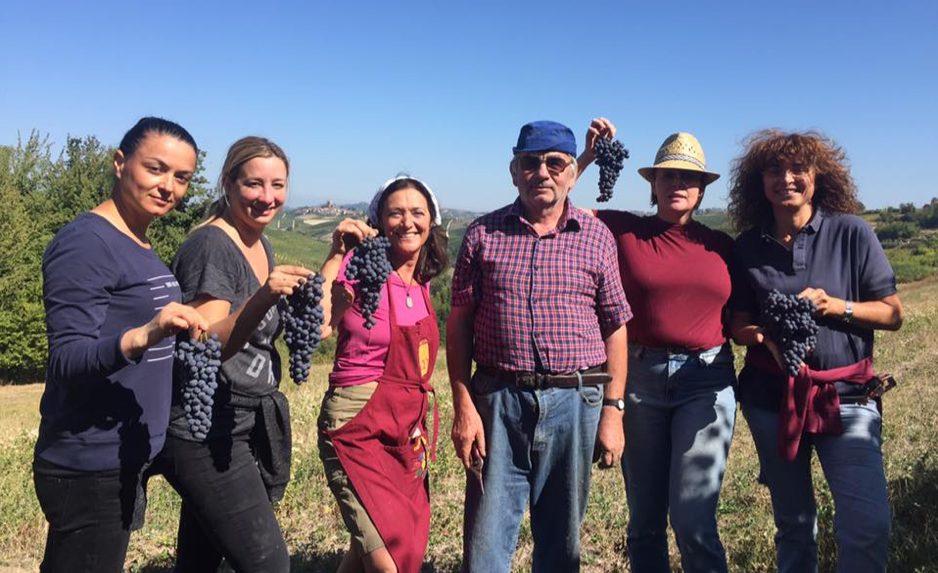 Chiara Boschis and her team during the 2017 harvest at E.Pira e Figli
Chiara Boschis and her team during the 2017 harvest at E.Pira e Figli
A reduction in production
As cited by several producers, spring frost and summer drought resulted in reduced yields across the board in 2017. Situated in the heart of Barolo, Chiara Boschis tells us that production at E.Pira e Figli was down between 10-20% on the 2016. The estate had to carefully select “clusters that were compact when picked”, as heat stress was preventing complete berry development. Marco Marengo notes that yields at his estate were 25% lower than average in 2017, while owner and winemaker at La Spinetta, Giorgio Rivetti, saw levels down by roughly 30%. A representative at Giacomo Conterno, Stephanie Flou tells us that its 2017 vintage was particularly affected by it being “the second year in a row in which [the estate] has suffered drought”. She states that while yields were limited “because the grapes dried out”, they are “positively surprised with how the vintage has ended up”.
Finding shade from the sun
Numerous estates noted the need for rigorous canopy management in 2017 – one of many adjustments applied across the region to cope with the extreme heat. Elio Altare’s second-generation winemaker, Silvia Altare tells us that hydric stress forced her to be amongst the vines, “meticulously managing the canopies to protect the grapes from the sun”. The team at Cantina Cooperativa Terre del Barolo also explain that this “was key in 2017 in order to keep bunches in shade, without suffocating them”, while “conservation tillage – mulching or grass covering in between the rows –was crucial to limit evaporation, and to protect the vines from the ‘mirror effect’ of the soil”. Vietti’s winemaker, Luca Currado notes that he similarly used “uniform, dense foliage to provide clusters with greater shade” and “grass cover between the rows to prevent sunlight reflecting directly onto the clusters”. The estate also started harvest significantly earlier than usual in 2017 – another recurring theme across the properties.
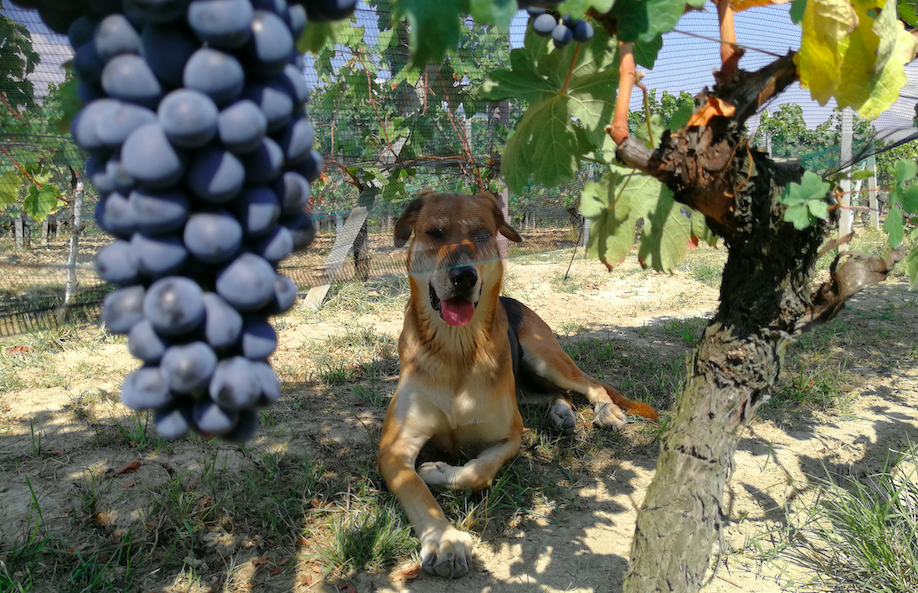 Keeping cool: the family dog at Elio Altare finds shade under the vines during the estate’s 2017 harvest
Keeping cool: the family dog at Elio Altare finds shade under the vines during the estate’s 2017 harvest
A crucial cooling
As mentioned by several of his peers, Azelia’s fifth-generation winemaker, Lorenzo Scavino tells us that a large diurnal temperature range helped to “preserve the freshness and the aromas of the grapes” in such a hot year. He states that while these cool nights “usually do not occur in warmer vintages, they were really a blessing”. Poderi Luigi Einaudi’s team echoed this sentiment, add that the temperature changes between day and night helped to develop the “polyphenolic profile of the Nebbiolo”, allowing “an excellent accumulation of tannins”. Rainfall in early September also helped to ensure balance in the 2017 vintage, with Luca Currado informing us that Vietti’s “Nebbiolo and Barbera benefited in particular, with highly complex polyphenolic profiles compared to other particularly rich vintages”, and “an unexpected freshness on the palate”.
The final freshness
Indeed, according to Wine Lister’s discussions with producers, freshness has been the great surprise of the 2017 vintage – a description applied repeatedly by Wine Lister’s partner critic, Antonio Galloni, in his notes on the region’s latest offerings. Chiara Boschis notes that E. Pira e Figli’s 2017 is “generous but very fresh”, while Azelia’s Lorenzo Scavino explains that rigorous vineyard management allowed them to “preserve the acidity, which is why even in this vintage we can find a great freshness”. Silvia Altare also tells us that while “2017 is definitely a warmer, more open knit vintage than 2016”, she has “noticed over the past few months the wines have integrated more and there’s a bit more freshness”.
The successful conception of balance in a year defined by drought aptly illustrates the resilience of Barolo’s producers in 2017, which may well be described as a winemaker’s vintage. Barolo 2017 scores have so far been high across the board, giving further merit to those who have created a wine of complexity and quality in a year of climatic uncertainty.
Keep track of new Barolo 2017 scores from Wine Lister’s partner critics here.
On 11th February, Sassicaia 2018 was released at £150 per bottle (in-bond), 6% up on the release price of the 2017.
Wine Lister attended an online tasting of this new release, as well as Guidalberto and Le Difese 2019, hosted by Armit Wines and Sassicaia’s third-generation director, Priscilla Incisa della Rocchetta. Armit’s Managing Director, Brett Fleming noted the uptake on all three wines has been excellent: “it has been an extremely successful launch from Tenuta San Guido over the past two weeks. Update and demand have been far in excess of anything we’ve been able to manage”.
Though all three wines are made in the large majority from international grape varieties, Priscilla’s observation that “Cabernet [has] found its sense of place in Bolgheri” shines through the wines. Each has its own distinct character, but with a fundamentally Tuscan undertone.
Background
Sassicaia began as the passion project of Marchese Mario Incisa della Rocchetta. While studying agriculture at the university of Pisa, he developed a penchant for wine from Cabernet vines, and subsequently invested in his own, so as to have wine for his family and friends that appealed to his tastes.
During the Zoom tasting, Priscilla told us that in the 1960s, Marchese Mario’s third son, (and Priscilla’s father) Marchese Nicoló, managed to convince him to begin distributing the wine, “transforming his hobby into something resembling a business”. Over the last half-century, the agricultural focus of Sassicaia’s 2,500-hectare estate has shifted increasingly towards top-quality winemaking. Still continued today nonetheless is the breeding of race-horses on the estate, as well as the preservation of a 500-hectare wildlife reserve.
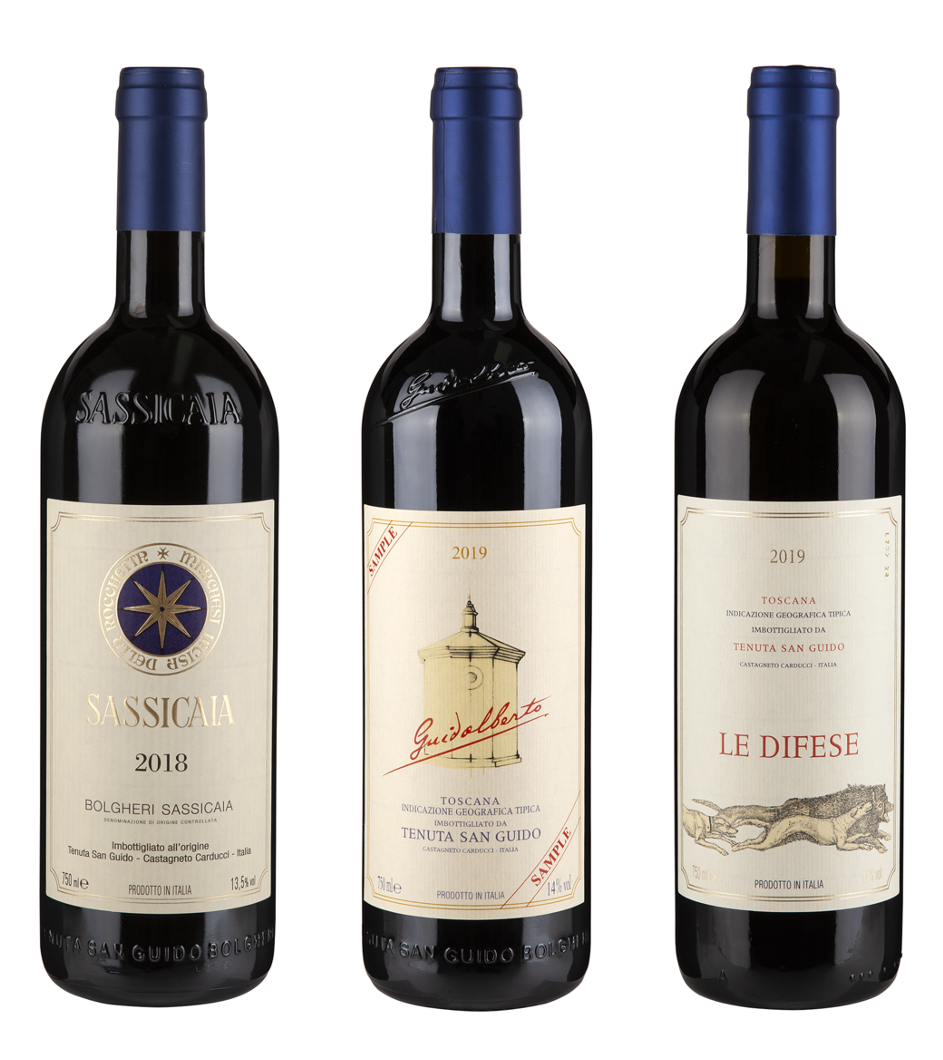 Official photos courtesy of Tenuta San Guido
Official photos courtesy of Tenuta San Guido
Sassicaia 2018
This is the 50th vintage of Sassicaia to be released onto the global wine market. Priscilla notes that “8” is usually a lucky number, and this was the case once again for the growing season resulting in this year’s anniversary release.
The wine leaps from the glass, with an energetic nose featuring suave red fruit, and a floral note of cherry blossom. The palate shows great depth – red cherries and plums as well as an earthier undertone, matched with a fine, elegant texture, particularly lifted by the wine’s vibrant acidity.
Guidalberto 2019
The only wine of the three tasted from a cask sample, the latest release from Guidalberto shows a sultry wine with impressive structure, yet seamless integration of its elements. The fruit profile is darker than its big cousin, but the same lift and freshness resounds on the palate, giving the wine a round and long finish.
Priscilla explains that the 2019 vintage was “warmer than other preceding vintages, not as much as 2017 or 2012, but comparable with 2009”. She continues, “we had a dry and mild winter, cool and rainy spring, but a regular summer, apart from rain during the middle of August which brought fresh air that allowed grapes to stay longer on the vines”. This small interruption to the ripening gave the Merlot a little extra time to soften.
She shares with us during the tasting the big news for Guidalberto – after postponing building plans for a brand new cellar of its own due to Covid restrictions, the works are finally underway, and the wine is set to have its own home, completely separate from Sassicaia, by 2023.
Le Difese 2019
After nearly 20 years in production (its first vintage was 2002), Le Difese proves itself a vibrant and well-balanced drinking wine. The 2019 shows an intense and immediate nose of sour cherry, and pure, juicy red berries on the palate.
Priscilla comments on its design; “[It] should be a wine that’s easy to drink, enjoyable young, aromatic but with some good structure because of the Cabernet Sauvignon”. The winemaking team has chosen to increase the amount of Sangiovese in the blend of the 2019 (from 30% up to 45%), so as to better service market demand for an easy-drinking wine that is approachable younger.
 “Another big step in the right direction for this château in revealing its excellent terroir” – Wine Lister, CEO Ella Lister, who visited Pavie’s owner, Gérard Perse (pictured) last year
“Another big step in the right direction for this château in revealing its excellent terroir” – Wine Lister, CEO Ella Lister, who visited Pavie’s owner, Gérard Perse (pictured) last year

 Left: Baptise Guinaudeau of Lafleur and Grand Village / Right: Véronique Sanders of Haut-Bailly and Le Pape
Left: Baptise Guinaudeau of Lafleur and Grand Village / Right: Véronique Sanders of Haut-Bailly and Le Pape






 Official photos courtesy of Tenuta San Guido
Official photos courtesy of Tenuta San Guido